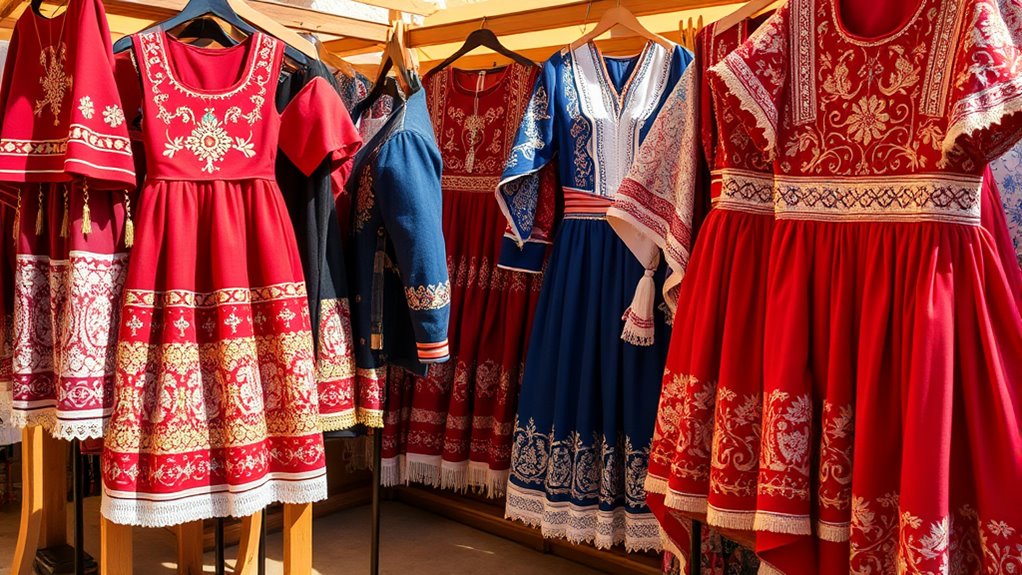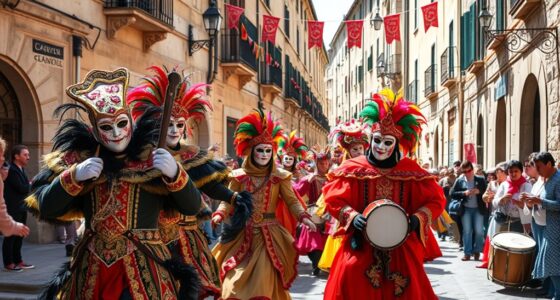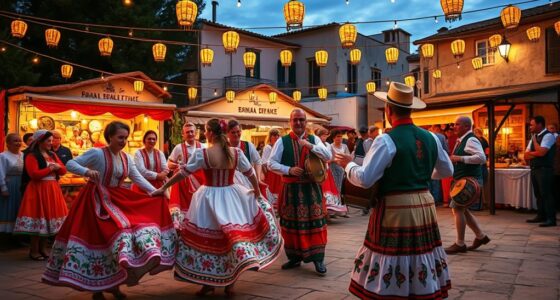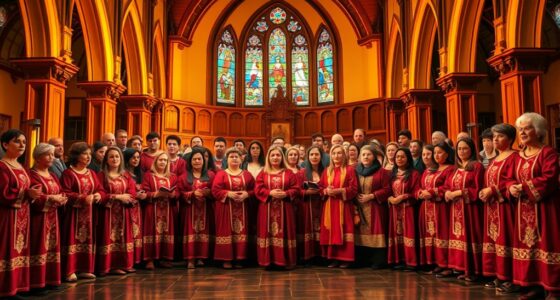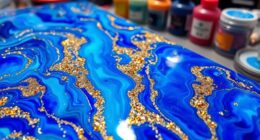Prendas De Ittiri is an annual artisan fair celebrating Sardinian heritage through traditional crafts, textiles, and stonework. You’ll experience authentic embroidery, weaving, and jewelry that showcase regional techniques and symbols. The event highlights the use of local materials like pink trachyte stone and natural fibers, supporting cultural preservation and community pride. By exploring this fair, you’ll discover how craftsmanship strengthens Sardinia’s identity—keep exploring to learn more about this vibrant cultural celebration and its significance.
Key Takeaways
- Prendas De Ittiri is an annual artisan fair celebrating Sardinian crafts and cultural heritage.
- The fair showcases textiles, embroidery, stonework, and jewelry made with traditional techniques.
- It promotes community pride, cultural preservation, and intergenerational transmission of artisanal skills.
- The event supports local artisans, boosts regional economy, and encourages sustainable craft practices.
- Prendas De Ittiri highlights regional materials like trachyte and natural fibers, emphasizing Sardinian identity.
Celebrating Sardinian Heritage Through Crafts
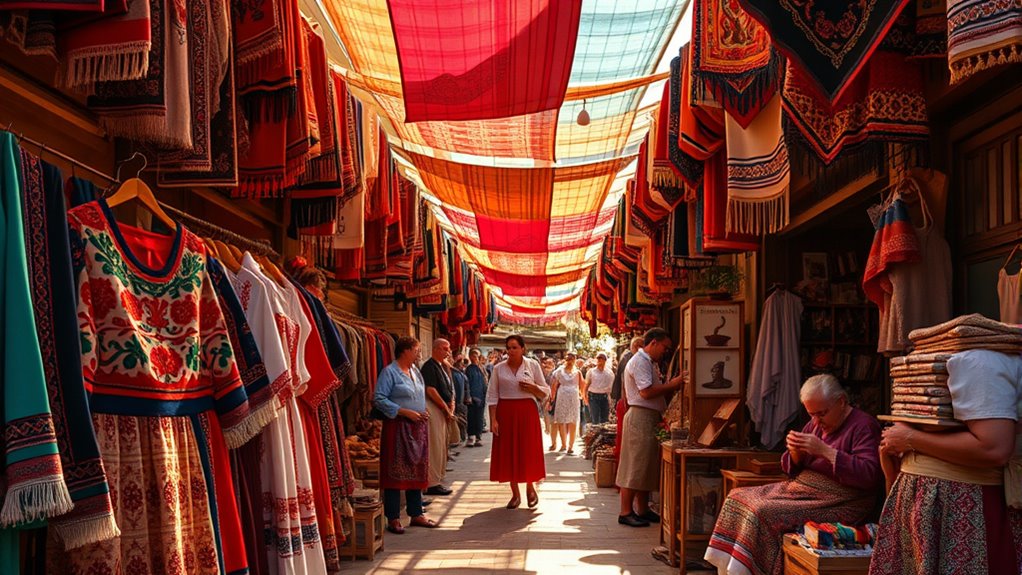
Celebrating Sardinian heritage through crafts is a vibrant way for Ittiri to preserve its cultural identity. The town’s rich tradition in textiles, embroidery, and trachyte stone processing highlights its deep-rooted artisanal skills. Local artisans work with passion, creating intricate embroidery and weaving textiles that showcase Sardinian motifs. Trachyte, a pink volcanic stone, shapes sculptures and architectural details, connecting craft to the landscape. Festivals like Prendas de Ittiri and the Folk Festa celebrate these traditions, fostering community pride and attracting visitors. These events not only showcase craftsmanship but also support local economies by providing artisans a platform to sell their work. Ittiri is located in Sardinia, an island known for its rich cultural heritage and traditional crafts., Through these crafts, Ittiri keeps its cultural legacy alive, blending history, art, and community into a colorful tapestry.
Traditional Textiles and Embroidery Showcase
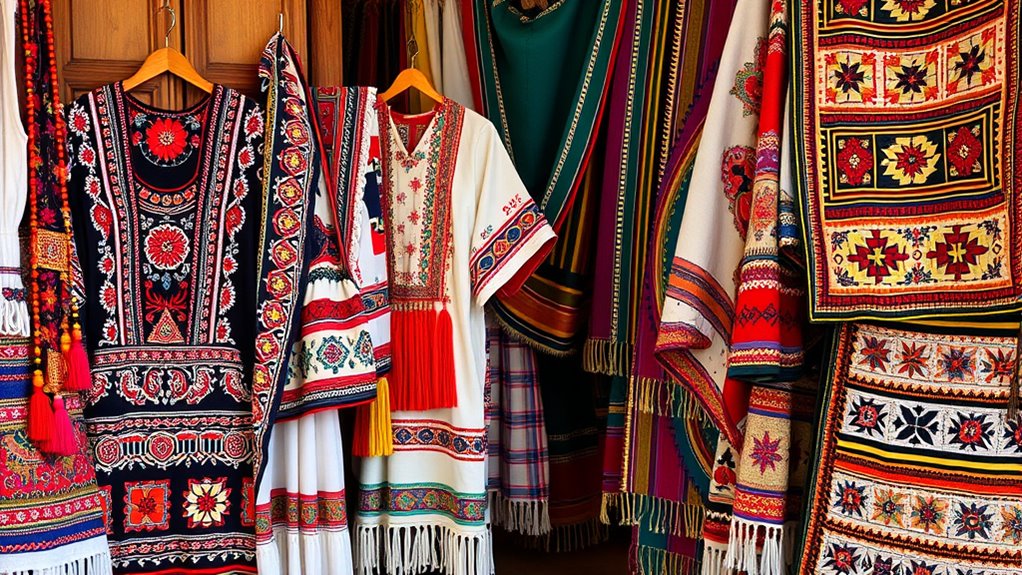
You can see how heritage techniques are being revived through the intricate details of Ittiri’s textiles and embroidery. Artisans skillfully use traditional methods and materials to create authentic garments and rugs that tell Sardinian stories. These handcrafted pieces showcase the rich craftsmanship passed down through generations and celebrated at local fairs. The preservation of these traditional arts helps sustain the cultural identity of Ittiri and promotes sustainable local economies. Additionally, the use of traditional techniques ensures the durability and uniqueness of each piece, further emphasizing their cultural significance.
Heritage Techniques Revived
The revival of heritage textile techniques breathes new life into age-old craftsmanship, ensuring that traditional weaving and embroidery practices are preserved and passed down. You’ll see artisans mastering back strap loom weaving, double ikat dyeing, and intricate hand embroidery—techniques specific to their regions. They use natural fibers like camelid hair and plant-based mordants, keeping original materials alive. Double Ikat, or Telia Rumal, involves pre-tying yarns and natural dyes like sheep dung and castor seed oils to achieve vibrant colors. Geometrical designs are carefully mapped and executed, while embroidery borders feature yarn tassels and fringes for ceremonial textiles. These techniques are taught to younger artisans, maintaining standards of yarn preparation, dyeing, and weaving, ensuring the authentic quality of each piece endures. Additionally, regional craftsmanship is reinforced through community workshops that emphasize the importance of traditional methods and cultural heritage. These initiatives also foster artisanal skill development, which is crucial for sustaining the community’s unique textile identity.
Artisan Textile Details
Traditional textiles from Ittiri showcase a rich array of materials and craftsmanship that reflect Sardinia’s cultural heritage. You’ll notice the use of wool and linen fibers, valued for their durability and natural availability. Natural dyes from local plants create earthy reds, blues, and ochres, giving each piece a unique, organic hue. Handspun yarns maintain ancient traditions, ensuring authenticity. The fabrics often have a tight weave and thick texture, ideal for both ceremonial garments and everyday rural wear. Goat and sheep wool provide warmth and flexibility, perfect for making carpets and costumes. These textiles serve functional and symbolic purposes, often decorated with embroidered geometric and floral motifs. Embroidery techniques like cross-stitch and satin stitch add detail, with metallic threads highlighting status and craftsmanship. The local artisans preserve traditional weaving techniques, which have been passed down through generations, contributing to the town’s reputation for high-quality craftsmanship.
The Art of Pink Trachyte Stonecraft
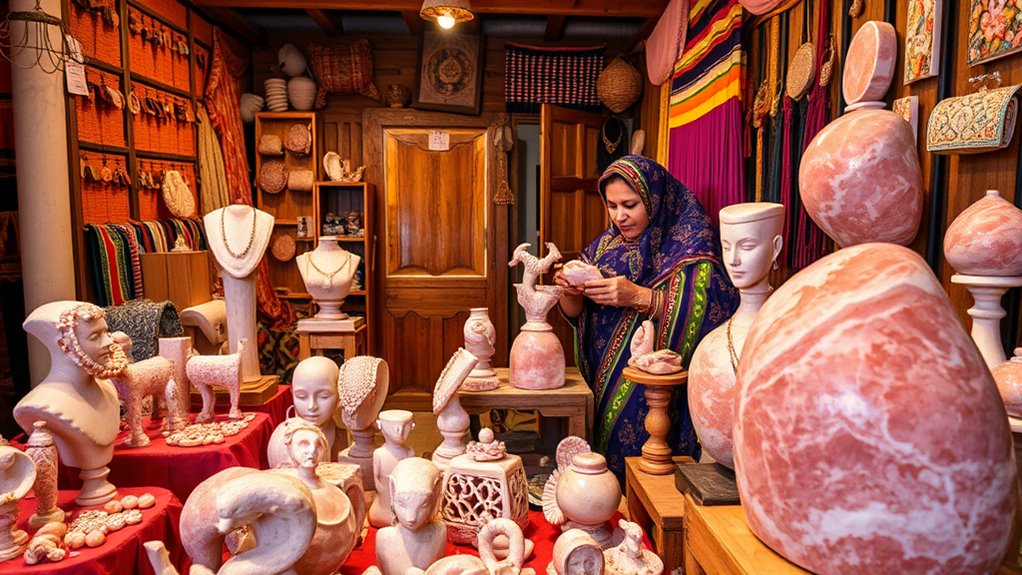
Pink trachyte has a rich history rooted in volcanic regions, shaping local traditions and craftsmanship. Artists use specific carving techniques that highlight its durability and unique texture, creating intricate designs. Today, contemporary artisans blend traditional methods with modern styles to showcase its versatility and cultural significance. Trachyte’s mineral composition, mainly alkali feldspar, contributes to its distinctive appearance and makes it an ideal material for detailed carving and durable sculpture work. Additionally, the volcanic origin of pink trachyte enhances its natural beauty and reinforces its importance in regional cultural identity.
Historical Significance of Trachyte
Because of its unique combination of durability and aesthetic appeal, pink trachyte has played an essential role in shaping regional craftsmanship traditions. Its availability and workability made it a favorite for sculptures, architecture, and artifacts, especially in volcanic areas like Ittiri. The stone’s resistance to weathering has preserved many historical monuments, anchoring cultural identity. You can see its influence in local artisan fairs, where craftsmanship continues to honor this heritage. Additionally, its physical properties make it an ideal material for both functional and decorative purposes. Below is a table highlighting key aspects:
| Aspect | Significance |
|---|---|
| Geological Composition | Rich in alkali feldspar, giving it pink hues |
| Cultural Use | Used in sculptures and architecture for centuries |
| Durability | Resistant to weathering, ensuring longevity |
| Texture | Porphyritic, offering visual and tactile appeal |
| Economic Impact | Contributed to regional craftsmanship and trade |
Techniques in Stone Carving
The artistry involved in shaping pink trachyte begins with selecting the right tools and mastering fundamental techniques. You’ll use rotary tools with specific cutters for detailed carving, creating sharp edges and textured surfaces. Wet tile saws help you cut thin slices, reducing dust, heat, and stone damage. Hand tools like hammers and copper chisels shape harder sections by gently removing material without cracking the stone. Flat tip rotary bits speed up flattening large areas while maintaining control over depth and contours. You must carefully manage cutting speed, tool sharpness, and moisture to prevent fractures and preserve the stone’s fine-grained texture. Layering techniques, such as varying heights and edges, add depth and complexity, making your carved pieces visually dynamic and tactile. Proper material selection and technique are crucial for achieving the desired finish and durability in pink trachyte stonecraft. Additionally, understanding stone properties helps artisans select the appropriate methods to enhance the stone’s natural beauty and longevity.
Contemporary Artistic Uses
Contemporary artists harness the unique qualities of pink trachyte to create striking works that blend tradition with innovation. They use its porphyritic texture and appealing pink hues to craft sculptures, architectural details, and decorative elements. Its moderate hardness and light weight make carving detailed designs easier while ensuring durability. Artists often combine pink trachyte with metals and glass, expanding its artistic potential. This versatility allows for public monuments, modern interiors, and mixed-media art. The stone’s high impact and weather resistance enable outdoor installations that withstand the elements. Its color palette and texture add warmth and depth, making it a favorite in contemporary design. Whether in traditional or modern contexts, pink trachyte bridges cultural heritage with innovative expression. The natural variations in its texture and color further enhance its appeal for diverse artistic applications.
Culinary Delights and Local Specialties

Have you ever tasted Sardinia’s rich culinary tapestry, where seafood, meat, and traditional breads come together in vibrant flavors? You’ll find iconic specialties like bottarga, a cured roe grated over pasta or sliced as a starter, prized locally. Burrida, a fish stew with skate or dogfish simmered in broth with lemon, varies by region, offering unique twists. Seafood fregola, toasted semolina pasta balls cooked with saffron and seafood, boasts a nutty flavor and chewy texture. Sardinian antipasti like carciofi e bottarga combine artichokes with sliced bottarga, olive oil, and lemon juice. Meat dishes such as suckling pig roasted with myrtle and juniper or lamb stewed with artichokes highlight local flavors. Traditional breads like sa coccio and intricately shaped loaves complete this flavorful island culinary heritage. Many of these dishes are best enjoyed in the artisanal food environment of local fairs, where traditional cooking methods are preserved.
Architectural Heritage and Artistic Innovations
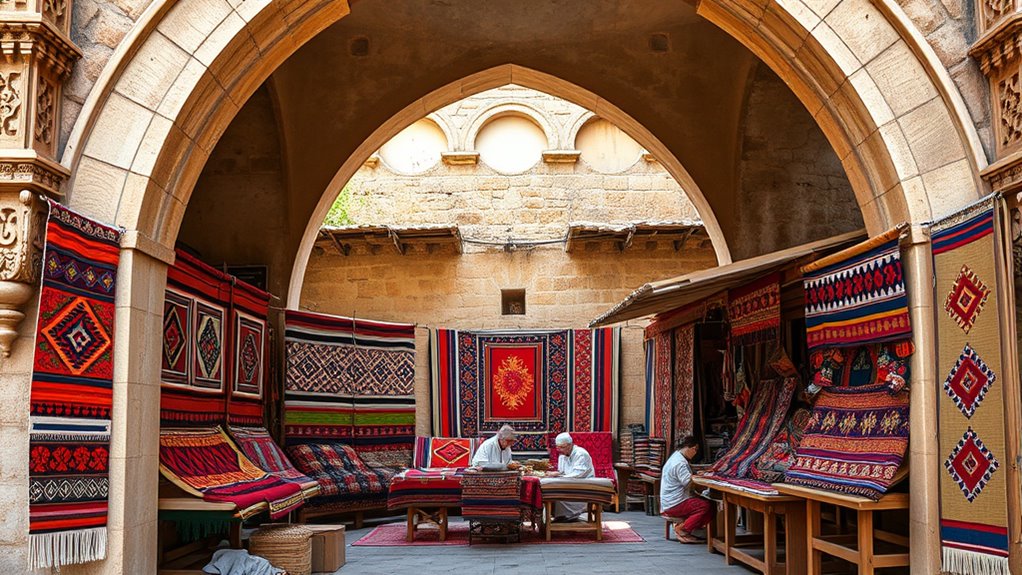
You can see how Ittiri’s architecture reflects its layered history, from Nuragic remnants to medieval monasteries and baroque palaces. Today, artists and craftsmen incorporate these traditional elements with modern techniques, creating innovative works that honor the past. This blending highlights the town’s ongoing commitment to preserving its heritage while embracing artistic evolution. The use of self-watering plant pots demonstrates how traditional craftsmanship can be adapted with contemporary innovations to promote sustainability and ease of care in gardening practices.
Heritage Architecture Significance
What makes Ittiri’s architectural heritage truly significant is its seamless blend of artistic innovation and historical preservation. You observe this in the baroque palaces and liberty/deco buildings adorned with intricate balconies and façades crafted from local Ittcherian trachyte stone. The streets, especially Via Cavour, retain their original cobbled surfaces, giving you a genuine sense of history. Religious sites like San Pietro in Vincoli and San Francesco highlight centuries of spiritual architecture, while medieval churches and Nuragic sites deepen the area’s ancient roots. These structures demonstrate skilled craftsmanship and regional materials, reflecting evolving construction techniques over time. Their preservation underscores Sardinia’s rich cultural tapestry, connecting past and present through architecture.
| Heritage Elements | Significance |
|---|---|
| Medieval Churches | Religious & historical continuity |
| Nuragic Sites | Prehistoric cultural heritage |
| Local Trachyte Stone | Artistic craftsmanship & durability |
| Cobblestone Streets | Authentic historical character |
Contemporary Art Integration
Contemporary art has become an integral part of Ittiri’s architectural landscape, seamlessly blending modern expressions with historic structures. During the trachyte biennial, you’ll notice contemporary sculptures that integrate local pink trachyte, creating a dialogue between tradition and innovation. Art Nouveau buildings like Palazzo Sussarellu stand alongside new installations, fostering a vibrant conversation between past and present. Themes rooted in Ittiri’s rural economy—artichokes, cheese, wine—are echoed in modern artworks, connecting local heritage with creative evolution. Sculptures and installations from competitions remain in public spaces, transforming the town’s visual identity. This fusion enriches the town’s cultural fabric, making contemporary art an active, living part of Ittiri’s architectural heritage. Recognizing the importance of emotional support in fostering community resilience, local organizers often incorporate community-centered art projects that promote social cohesion.
The Role of Agriculture in Artisanal Products
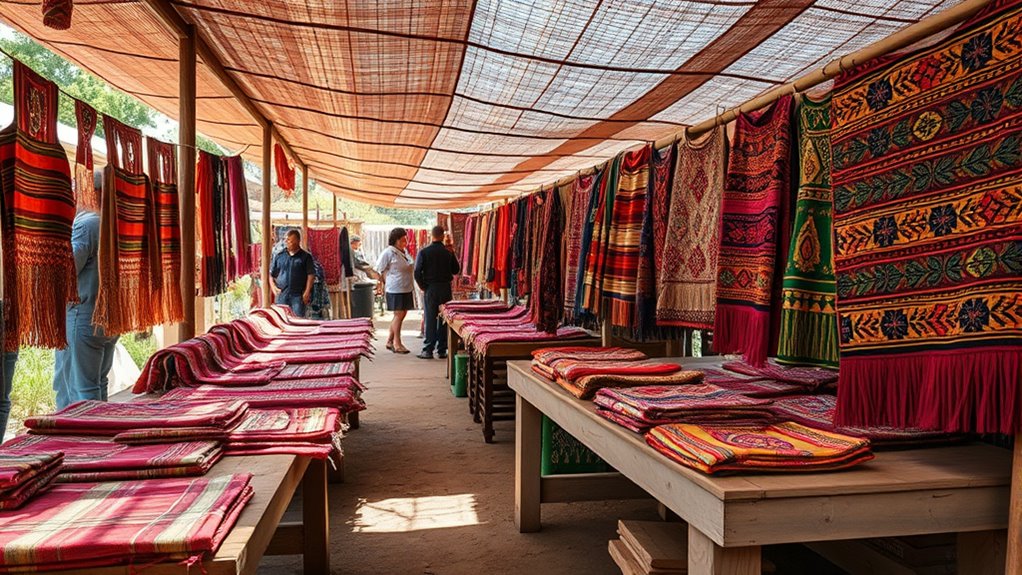
Agriculture forms the backbone of artisanal products by providing essential raw materials such as milk, grapes, meat, and honey. These ingredients are indispensable for producing unique, high-quality goods that define regional craftsmanship. You’ll find that:
- Dairy products like milk are essential for artisanal cheeses, which drive demand in the food sector.
- Grape cultivation supports the production of distinctive artisanal wines.
- Small-scale farms supply meat from cattle, pigs, and poultry, used in traditional meat products.
- The use of local, sustainable farming practices helps preserve the environment and maintain the integrity of artisanal goods.
Most artisans rely on local, household, or micro-farms to secure these raw materials, ensuring freshness and authenticity. This close link between agriculture and artisanal crafts sustains regional identities, boosts local economies, and promotes sustainable farming practices that keep traditions alive.
Engaging Activities and Interactive Workshops
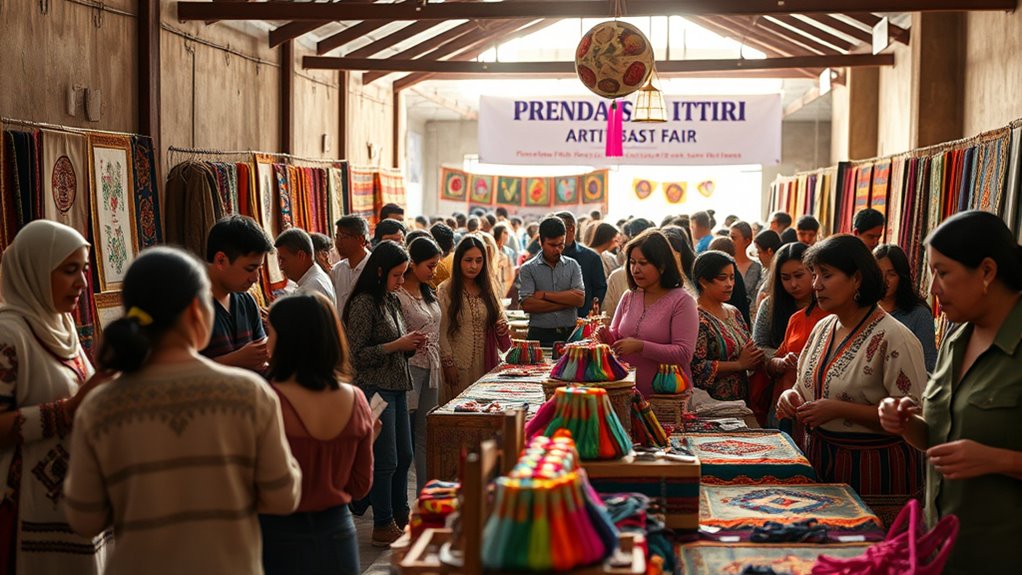
Participating in engaging activities and interactive workshops at the Prendas de Ittiri festival allows you to immerse yourself in the region’s rich cultural traditions. You’ll experience traditional textile demonstrations, learn embroidery techniques, and explore local crafts like textiles and trachyte artworks. The workshops give you hands-on opportunities, such as weaving with looms, decorating fabrics, and natural dyeing. Trachyte sculpture events highlight local craftsmanship, while folk dances bring the community’s vibrant spirit to life. Here’s a glimpse of what to expect:
| Activity Type | Description | Participants |
|---|---|---|
| Textile Demonstrations | Weaving and embroidery showcases | Visitors |
| Sculpture Events | Trachyte carving competitions | Art enthusiasts |
| Folk Dances | Traditional performances | All attendees |
Connecting Local Artisans With Broader Sardinian Networks
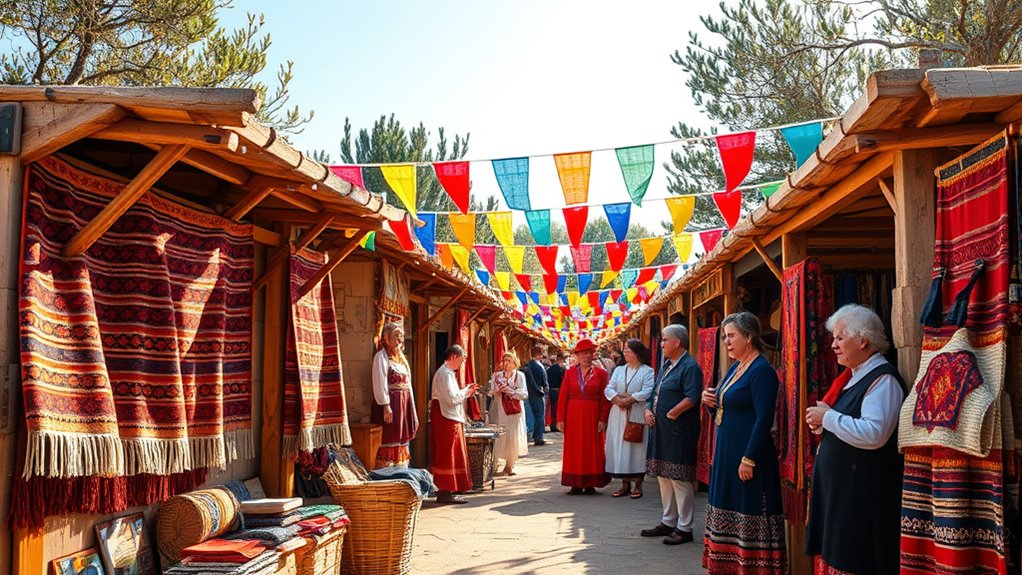
Connecting local artisans with broader Sardinian networks plays an essential role in preserving and promoting the island’s rich craft heritage. These connections expand market reach, encourage knowledge sharing, and strengthen regional identity. You can expect these networks to:
- Facilitate participation in Sardinian artisan fairs like Mogoro’s “Fiera dell’Artigianato Artistico,” showcasing diverse crafts from jewelry to ceramics.
- Promote collaboration among artisans from different regions, fostering innovation while maintaining traditional techniques like embroidery, stonework, and knifemaking.
- Enhance visibility for artisanal products, boosting sales and economic sustainability for local communities.
- Strengthen regional identity by creating platforms for artisans to share stories and cultural significance behind their crafts, fostering pride and continuity in Sardinian traditions.
Complementary Festivals and Cultural Events
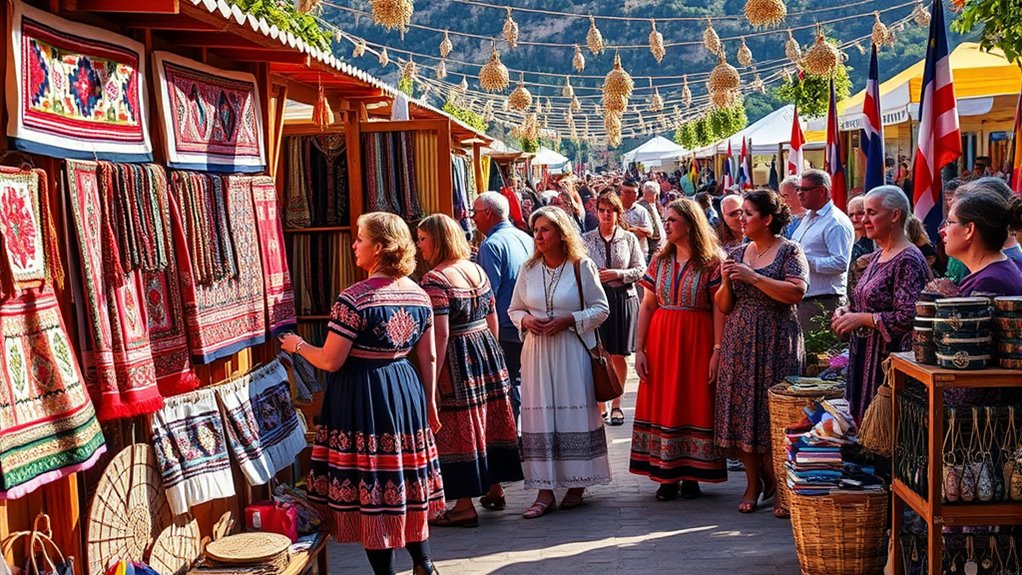
Complementary festivals and cultural events play a essential role in enriching the atmosphere of Prendas De Ittiri by showcasing Sardinia’s diverse traditions. During these events, you’ll witness colorful processions honoring saints, like the Sagra di Sant’Efisio, with folk groups, horses, and traditional costumes. Torchlight processions in Castelsardo and Holy Week rites deepen the island’s spiritual heritage. You can also enjoy lively folk music at events like the Ittiri Folk Festa, featuring “canto a tenore,” alongside international jazz festivals. Food festivals, such as the Fish Festival, combine regional seafood with artisans’ crafts. These gatherings create a vibrant tapestry of faith, music, and cuisine that amplifies the cultural richness of Prendas De Ittiri.
| Festival | Key Features | Timing |
|---|---|---|
| Sagra di Sant’Efisio | Folk groups, horse-drawn carriages | May |
| Ittiri Folk Festa | Folk music, traditional costumes | Summer |
| Holy Week rites | Religious processions, artifacts | Holy Week |
| Fish Festival | Seafood, local crafts | July |
The Impact of the Fair on Ittiri’s Cultural Identity
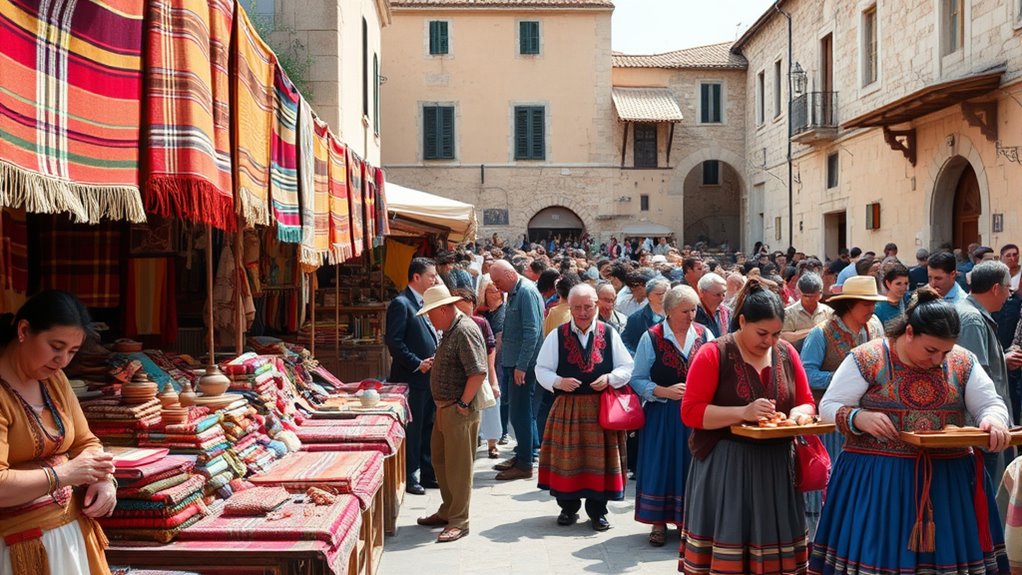
The Prendas de Ittiri fair plays a essential role in strengthening the community’s cultural identity by showcasing traditional clothing, artisan crafts, and local history. This event highlights the vibrant Teleta tradition, with efforts like the Permanent Observatory on Teletas ensuring its preservation. It also celebrates Sardinian jewelry, such as “Is Prendas,” linking past practices to present pride. Through the fair, you see a clear focus on intergenerational transmission, where elders teach craft skills and share stories, fostering cultural continuity. Participating in dressing in traditional attire or creating jewelry strengthens community bonds. Additionally, the fair boosts local pride by publicly recognizing Ittiri’s unique cultural attributes, making the community’s rich heritage visible and valued for future generations.
Frequently Asked Questions
How Can Visitors Purchase Authentic Sardinian Crafts at the Fair?
You can purchase authentic Sardinian crafts by visiting stalls directly operated by local artisans, who showcase genuine textiles, sculptures, and garments made with traditional techniques and materials. Engage with the artisans, ask about their craft’s history, and look for labels or workshop names as proof of authenticity. Pay with cash or cards, compare different booths, and consider buying local food products to enrich your cultural experience.
Are There Opportunities for Visitors to Participate in Craft Workshops?
You might wonder if you can join craft workshops at the event. While the fair mainly showcases artisan skills through exhibitions and demonstrations, there’s limited evidence of structured hands-on workshops. However, you could have informal opportunities to observe and perhaps interact with artisans. In the future, the event could expand to include more participatory workshops, giving you a chance to learn traditional techniques firsthand.
What Specific Traditional Techniques Are Showcased During the Fair?
Imagine walking through a vibrant tapestry of Sardinian heritage, where each thread tells a story. You’ll see artisans spinning wool and flax by hand, dyes drawn from nature’s palette, and intricate weavings dancing on wooden looms. Embroidery and lace-making bring regional motifs to life, while costumes for dance and performance showcase centuries of tradition. It’s a sensory journey, revealing the skill and soul woven into Sardinia’s rich textile legacy.
How Does the Fair Support Local Artisans’ Economic Sustainability?
You support local artisans’ economic sustainability by buying their products directly at the event, which helps them earn higher profits. The fair opens new markets for their crafts, allowing them to reach more customers. Plus, engaging with the community gives you insight into their needs and preferences, encouraging artisans to improve their work. This ongoing support helps preserve traditional crafts and boosts their long-term economic stability.
Are There Guided Tours Highlighting Ittiri’S Architectural Heritage During the Event?
You might wonder if guided tours focus on Ittiri’s architecture during your visit. While there aren’t official, scheduled tours specifically highlighting the town’s architectural heritage, the event’s timing and cultural atmosphere encourage exploration. Local artisans and associations could offer informal guides, sharing insights into traditional stonework and historic sites like the Abbey ruins. As the town develops heritage tourism, more structured architectural tours are likely to become available, enriching your experience.
Conclusion
So, next time you visit Ittiri’s “Prendas de Ittiri” fair, don’t just marvel at the crafts—pretend you’re a Sardinian historian in disguise. Immerse yourself in the textiles, nibble on the local treats, and maybe even try your hand at pink trachyte stonecraft. Who knows? You might leave with more than souvenirs—like a newfound appreciation for Sardinia’s rich heritage, or at least a good story to tell about that time you tried embroidery and failed spectacularly.
